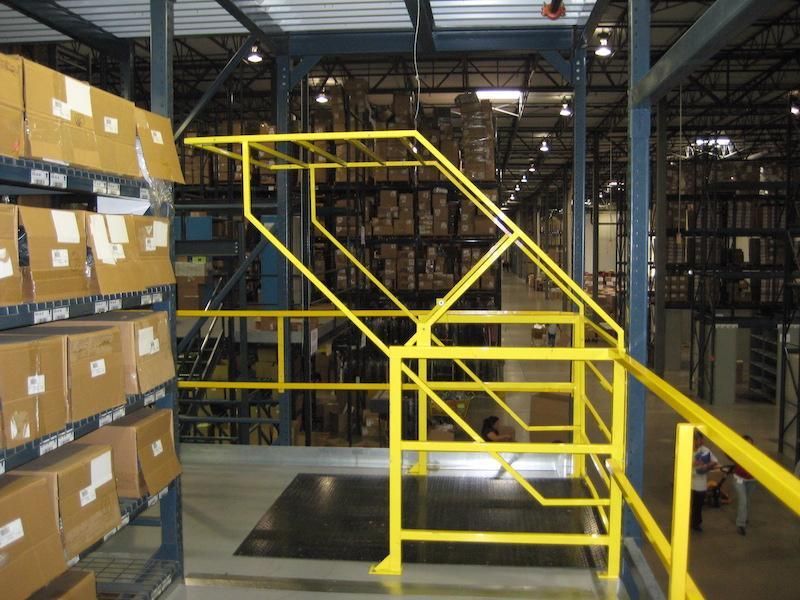
The Evolution of Pivot Safety Gate
The second dual-gate safety system we invented was the Pivot safety gate. The Pivot model was originally a custom designed safety gate for Pierce Leahy Archives, which was later purchased by Iron Mountain, and is a great solution for providing fall protection for multiple pallet drop areas. We engineered a simple design for the Pivot safety gate to limit the moving parts; the gate operates on just two pivot points. The design makes the Pivot model a good choice for many applications, including food processing plants where the entire design can be fabricated out of stainless steel.
Pierce Leahy required a safety solution in areas with limited available height and multiple levels of platforms used for record retention. The original Pivot model we created for this job consisted of a gate at the ledge and second gate behind the pallet, which used a pivoting framework that was manually operated to maintain a safe environment at all times while pallets are loaded into the area.
While traditionally offered in a few standard sizes, single wide and double wide, the basic Pivot safety gate design didn’t lend itself to much customization, so it was a good choice for operations with standard size pallet loads. The ability to fit this model in a low overhead space had the disadvantage of not accommodating a tall of a pallet load. However, we changed this for Cardinal Health who liked the simplicity of the Pivot safety gate but wanted to load taller pallets into the area.
To meet the needs of Cardinal Health, we added additional pivot points to the design to allow the gates to clear taller pallet load. This design became known as the High Pallet Pivot Model, which uses a total of 14 pivot points to clear taller pallets and to reduce the amount of space it takes up on the platform. A traditional Pivot gate can take up a lot of depth on a platform because the rear gate needs room to pivot back into the area when the gate is operated. This can be a problem on smaller mezzanines, but by adding pivot points, we were able to reduce the swing depth so the gate can clear the same size pallet in a smaller footprint. This is important because space is always significant – that’s why the mezzanine was built in the first place!
The High Pallet Pivot safety gate design with the multiple pivot points opened up endless possibilities for customization. By positioning the pivot points in strategic positions, we can modify the height and depth to accommodate odd-size pallet loads, fit in areas with limited heights, and work around obstructions on the platform. In food and chemical manufacturing plants, it’s very common to have reactors or hoppers positioned behind the pallet drop area, so it is important to be able to modify the depth of the pivot gate to work around this equipment.
The next evolution in the Pivot design was the introduction of a Rack Supported model, which was designed to meet the fall protection needs in the increasingly popular multi-level pick modules. These safety systems attach to the existing pallet rack to maximize space in the bay, and eliminate parts of the structure that could get hit and damaged by the lift truck. In addition, by attaching to the rack uprights, the safety gate doesn’t need to get lagged into the decking, which can vary in design and strength from project to project.
The Rack-Supported Pivot gate allowed picking positions and empty pallet and tote return bays to be permanently secured. This fall protection system is designed to attach to any style of pallet rack and can be configured to fit the specific bays and the products being loaded. The location of the pivot points can be modified so the gate doesn’t swing too far back into the picking aisle, so it can work around the takeaway conveyors or the narrow aisles.
The Pivot safety gate model has gone from being a simple concept and design for standard applications to something that can be customized and configured to fit various scenarios. What’s next for the Pivot model? Stay tuned.